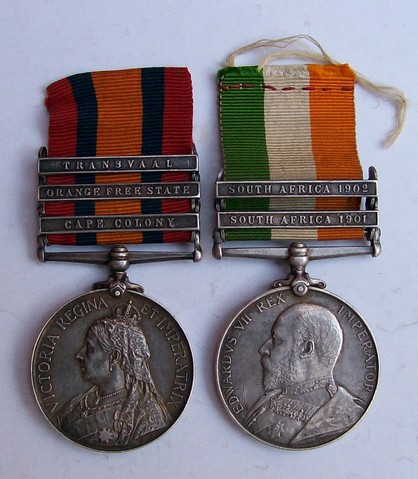William (Herling)Shaw in the Second Boer War 1899-1902 ?
According to family legend the
first William Herlingshaw lied about his age to join the army as an
under-age bugle boy or drummer in order to go to the second Boer War
in Transvaal and the Orange Free State, South Africa. No firm
evidence has yet been found to substantiate this and of course no Herlingshaw name appears
in the records. However, there were many William Shaws and W Shaws
there
and he would almost certainly was using the Shaw surname then. Below
are some of the possibilities, assuming of course that he enlisted
as Shaw and not something completely different. Family history (and
the "cat and cabbage" cap badge) suggests that if he was there he
was in the York and Lancaster Regiment and in that case the only
known candidate is Private 6237. If that was him, based on the
number sequence he would have signed up in middle to late 1900.
However, the actual cap badge in family possession uses a fixing
method that did not start until 1903, after the Boer war had ended. The mystery remains.
W Shaw, Private 5346, 2nd
Battalion, Middlesex Regiment
W Shaw, Private 2188, 3rd
Battalion The Queen's Own (Royal West Kent Regiment)
W Shaw, Private 6237, 1st
Battalion The York and Lancaster Regiment
W Shaw, Private 5539, 4th Battalion West
Yorkshire Regiment (but died in 1900)
W Shaw, Private 3213, 2nd
Battalion Loyal
North Lancashire Fusiliers
W Shaw, Private 3655, 2nd
Battalion Loyal
North Lancashire Fusiliers
W Shaw, Private 3060, 3rd
Battalion West India Regiment
W Shaw, Private 6961, 4th
Battalion Derbyshire Regiment (The Sherwood Foresters)
W Shaw, Private 4188, 13th
Hussars
W Shaw, Private 4478, 14th
(King's)
Hussars
W Shaw, Private 9006, 2nd
Battalion Coldstream Guards
W Shaw, Private 3961, 2nd
Battalion The King's Own (Royal Lancaster)
W Shaw, Private 7556, 3rd
Battalion The Kings Own (Yorkshire Light Infantry)
W Shaw, Private, Royal Marine
Light Infantry
W Shaw, Private 4736, 1st
Battalion Leicestershire Regiment
W Shaw, Trooper 26226, 104
(Derbyshire) Company, 4th Battalion Imperial Yeomanry
William Shaw, Private 4566,
1st Dragoon Guards (but was killed in 1901)
William Shaw, No. 6961,
Derbyshire Regiment
William Shaw, No. 4258,
1st Battalion Derbyshire Regiment (The Sherwood Foresters)
William Shaw, Private 5051, 8
(Derbyshire) Company, 4th Battalion Imperial Yeomanry
William Shaw, Private 12265,
66 (Yorkshire) Company, 16th Battalion Imperial Yeomanry
William Shaw, Trooper 35675,
75 (Sharpshooters) Company, 18th Battalion Imperial Yeomanry
William Shaw, Trooper 40464,
37th Battalion Imperial Yeomanry
William Shaw, Trooper 26482,
Orange River Scouts
The second Boer War started on
11th October 1899 and finished on 31st May 1902. At the start of the
war William would have been 14, almost 15 years old, at the end only
17½. The official enlistment age was 18 with 19 required for active
service overseas - but the rules were frequently ignored. To put
this into context the school leaving age was raised from 11 to 12 in
1899 and was raised again to 14 after WWI.
If William was in the Boer War he
would have received a medal, either the QSA (Queen's South
Africa Medal) or KSA (King's South Africa Medal) depending on the
date of the award - or both as the KSA was often issued with the QSA.
(Queen Victoria died on 22nd January 1901 and was succeeded by King
Edward VII). This is what the medals look like, with additional
"clasps" on each. These particular medals were awarded to Private
6048, H Shaw of the North Staffordshire Regiment - an interesting
coincidence but not thought to be a
relative. The recipient's name was then engraved on the rims of the medals.

In the second Boer War the
Imperial Yeomanry was a volunteer cavalry regiment. The Dragoon
Guards and The Hussars were cavalry regiments. The West Yorkshire
Regiment, Leicestershire
Regiment and the Loyal North Lancashire Fusiliers were infantry.
Another possibility is that
William was Private 1385 W. Herling of the 1st Battalion of the
Rifle Brigade who was in South Africa in 1901 and 1902 and received
the King's South Africa Medal and two clasps (one for each year).
However, this soldier is listed as C (or E) Herling elsewhere.
Some years after the Boer War
William joined the Army for a seven year period starting in 1906
but it is not know what he was doing in the intervening period.

The contents of this site are
copyright © 2022, Ken Herlingshaw.
|



